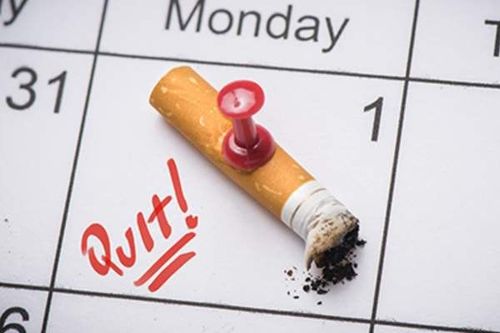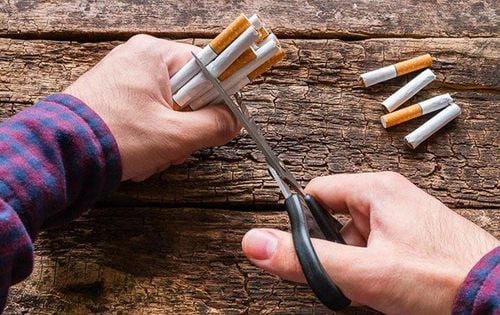This is an automatically translated article.
Until now, everyone understands how smoking affects health. Studies have reported that cigarette smoke contains about 4,800 compounds, of which 100 are carcinogenic. The smoke you breathe in not only affects your lungs, but also negatively affects every organ system of the body. Let's find out 9 body parts damaged by smoking.
1. Effects of smoking on health?
No matter how you smoke it, tobacco is dangerous to your health. There are no safe substances in any of the tobacco products, from acetone and tar to nicotine and carbon monoxide. The substances you breathe in through secondhand smoke affect more than just your lungs. They can affect many other parts of your body.
The International Agency for Research on Cancer (IARC) of the World Health Organization (WHO) has classified tobacco gas as a class 1 carcinogen. Hidden in smoke Drugs are about 4000 chemicals, and up to 40 of them are classified as carcinogenic such as: nicotine, formaldehyde, ammonia, carbon oxide, arsenic, tar and benzene, hydrogen cyanide, acetone... Only in small amounts these substances can also cause cancer, they are very toxic indeed. Not only that, smoking affects the heart, and blood vessels, the entire nervous system, the endocrine glands causing cardiovascular diseases, or memory loss.
The life time of smoke in the air can be more than 2 hours, even if you no longer see or smell it. Therefore, not only smokers have to suffer the consequences of second-hand smoke, but even people who often live or work next to smokers can receive the same amount of smoke as smoking 5 cigarettes a day.
In recent years, the Arab style of smoking tobacco (called hookah or shisha) has become more and more popular in many countries around the world especially among young people, as a hobby. playing "stylish" of young adults, they think that it is an affirmation of class and many people even tell each other that smoking this way is not harmful, or at least it is not as harmful as smoking. direct.
The American Journal of Preventive Medicine has just published a study: in which 31 volunteers aged 18 to 35 years old, were divided into two groups of cigarette smokers and smokers. wrap. The experiment was conducted after each time the volunteers smoked, measuring the amount of carbon monoxide and nicotine in the blood, checking the heart rate, the number of times the smoke was swallowed and the volume of that smoke. Researchers have found that smoking cigarettes has lower levels of carbon monoxide in the blood than cigarette smoking. The average number of smoke inhalations for a pipe smoker is 48 times higher than that of a cigarette, and both types of smoking lead to the release of nicotine into the bloodstream.
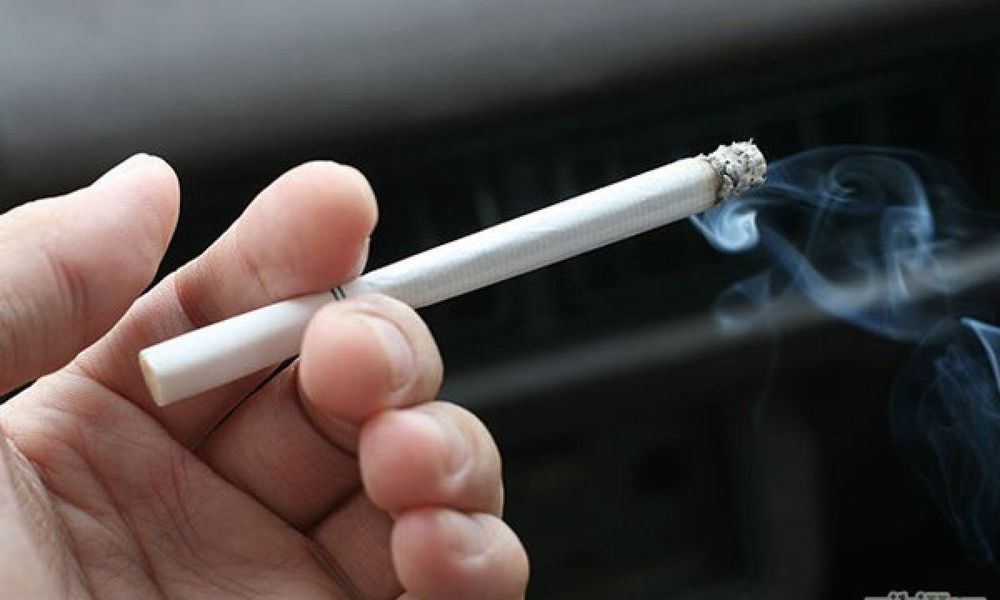
Hút thuốc ảnh hưởng như thế nào là thắc mắc của nhiều người hiện nay
Dangerous chemicals in tobacco: The highly damaging components of cigarette smoke include:
Nicotine narrows your veins and arteries. Can hurt your heart by forcing it to work faster and harder, slowing blood circulation and reducing the amount of oxygen reaching your feet and hands
Tar - is the word for solid particles suspended in cigarette smoke. The particles contain chemicals, including carcinogens (carcinogens). Tar is sticky and brown, and stains teeth, nails and lung tissue Carbon monoxide - a toxic gas. It is odorless and colorless and, in large doses, rapidly causes death because it displaces oxygen in the blood. In smokers, the carbon monoxide in their blood makes it difficult for oxygen to get to their organs and muscles. Oxidative chemicals - are highly reactive chemicals that can damage the heart muscle and blood vessels of smokers. They react with cholesterol, leading to a buildup of fat on the artery walls. Their actions lead to heart disease, stroke and vascular disease Metals - cigarette smoke contains several carcinogenic metals, including arsenic, beryllium, cadmium, chromium, cobalt, lead and nickel Radioactive compounds - Tobacco smoke contains radioactive compounds known to cause cancer. Diseases caused by tobacco smoke Tobacco causes about 25 different diseases for its users, including many dangerous diseases such as cardiovascular disease, respiratory disease, cancer and even it affects to reproductive health. It is necessary to mention the main diseases caused by smoking such as emphysema, lung cancer, hair loss, cataracts. According to statistics from the American Cancer Society: being in the same room as a smoker for every hour that passes, the risk of lung cancer is 100 times higher than living in a building containing arsenic in the air. 20 year period.
Tobacco is also one of the main causes of non-communicable diseases: tobacco causes 90% of lung cancer cases, 75% of chronic obstructive pulmonary disease cases and 25% of heart disease cases. Ischemic. It is estimated that in the United States tobacco is responsible for about 30% of cancer deaths.
2. 9 body parts damaged by smoking
2.1. Effects of smoke on the respiratory system Effects of smoke on the respiratory system include:
Irritation of the trachea and larynx causing coughing Decreased lung function and difficulty breathing due to swelling and narrowing of the lung airways and mucus excess in the lung segments Impaired clearance of the lungs, leading to accumulation of toxic substances, irritation and lung damage Increased risk of lung infection, symptoms such as coughing and wheezing appear more Permanent damage to the air sacs of the lungs.
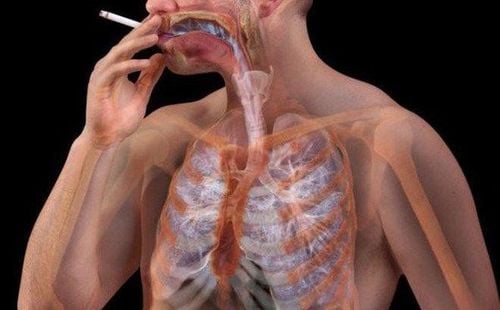
Ngoài việc hút thuốc ảnh hưởng đến tim mạch thì hệ hô hấp cũng bị ảnh hưởng
2.2. Smoking affects the heart, and circulatory system The effects of smoke on the circulatory system include:
It impairs endothelial function. The endothelium is the inner lining of the heart and blood vessels. Any damage to this inner lining precedes the development of heart diseases. Smoking causes the formation of blood clots in the blood vessels, which can easily lead to a stroke. Smoking also increases oxidative stress and inflammation, which has a negative effect on the functioning of the heart muscle. Increases blood pressure and heart rate Constricts blood vessels in the skin, resulting in a drop in skin temperature (vasoconstriction) Blood transports less oxygen during exercise Blood is more "sticky", more prone to clotting Mucosal damage of the arteries, which is thought to be a contributing factor to atherosclerosis (fatty buildup on artery walls) Reduced blood flow to extremities (fingers and toes) Increased risk suffered a stroke and heart attack due to a blockage in the blood supply.
2.3. Smoking affects the liver, and the digestive system Smoking affects the stomach, liver and the gastrointestinal tract in general in the following ways: - Increased secretions: Smoking reduces the strength of the lower esophageal sphincter and allows This allows stomach acid to back up into the esophagus, thereby causing heartburn and increased gastric secretion. - Peptic ulcers: The risk of infection with Helicobacter pylori bacteria, which causes peptic ulcers, is high in smokers. Chronic smoking also increases the amount of acid produced by the stomach. This damages the inner lining of the stomach and causes the formation of peptic ulcers.
- Liver: The chemicals produced when smoking cause oxidative stress, in which free radicals damage and destroy liver cells. This causes liver stiffness, leading to functional and structural changes. The liver's inability to detoxify toxic substances causes the accumulation of waste products in the blood and body. Furthermore, not only alcohol, but smoking also increases a person's risk of liver cancer.
2.4. Effects of Smoking on the Immune System Smoking affects both cell- and humoral-mediated immune responses. Nicotine suppresses the production of white blood cells and stops the cells from forming antibodies. This reduces the body's ability to fight bacteria and other foreign invaders, which can cause damage to the body. Nicotine also inhibits T cells, which are the most important weapon against harmful invaders. Studies have observed that stopping smoking reverses these effects and enhances both cell- and antibody-mediated immune responses.
2.5. Effects of smoking on the genitals Effects of smoking on the male body include an increased risk of: Lower-than-normal sperm count Higher percentage of malformed sperm Genetic damage to Sperm impotence, possibly due to the effects of smoking on blood flow and damage to the blood vessels of the penis. The effects of smoking on a woman's body include: Reduced fertility, menstrual disorders causing irregular periods or no period Menopause one or two years earlier Risk of cancer Cervical cancer greatly increases the risk of stroke and heart attack if a smoker is over 35 years old and takes birth control pills. 2.6. Smoking affects facial skin, hair * Skin
Smoking is associated with many dermatological conditions such as poor wound healing, acne, psoriasis, melanoma, squamous cell carcinoma, and aging premature skin aging. Smoking impairs collagen production and increases the formation of tropoelastin and matrix metalloproteinases. These compounds cause the breakdown of collagen, a protein responsible for skin firmness, elasticity, and younger-looking skin. This gives rise to early signs of skin aging such as fine lines, wrinkles, dark spots and dark circles.
* Hair
The papilla of the hair follicle contains many blood vessels that supply the necessary nutrients, thus nourishing the hair. Smoking damages these blood vessels and, in turn, causes hair loss. Smoking also damages the DNA of hair follicles affecting the hair growth cycle. Furthermore, smoking leads to the release of inflammatory compounds, which cause inflammation and fibrosis of the hair follicles.
2.7. Effects of Smoking on the Pancreas Exposure to cigarette smoke damages the pancreas, increases levels of digestive zymogens in the pancreas, and alters gene function. This increases your chances of getting pancreatitis. Furthermore, dangerous compounds from cigarette smoke damage the acinar cells of the pancreas, thereby reducing the secretion of digestive enzymes leading to indigestion. Nicotine also increases oxidative stress, which damages the cells of the pancreas and increases the risk of pancreatic cancer. It also accelerates the progression of chronic alcoholic pancreatitis.
2.8. Effects of smoking on teeth In addition to your teeth and tongue will be yellow, there are also problems such as
Pain, bleeding gums; painful chewing; Bad breath: Gum disease is the leading cause of tooth loss. If you smoke, you're twice as likely to get the disease, and the more you smoke, the higher your risk.
2.9. The effect of smoking on the brain If you smoke, you are 3 times more likely to have a stroke - a blood clot in the brain can cause any number of problems, including facial paralysis, blurred vision, difficulty walking and sometimes death. You're also more likely to have high blood pressure, which can lead to brain aneurysms. This is when the wall of a blood vessel in your brain peels off. It can leak or burst and spill blood into nearby tissues.
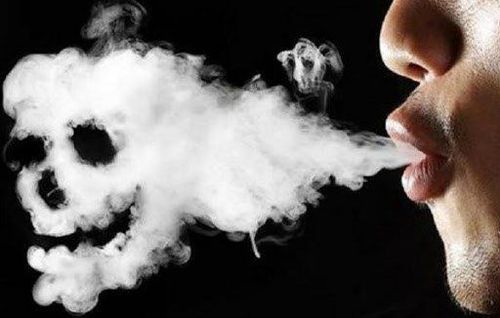
Không chỉ hút thuốc ảnh hưởng đến gan mà não bộ cũng bị tác động đến
3. Effects of secondhand smoke on children that mothers should know
The effects of maternal smoking on the fetus include:
Increased risk of miscarriage, stillbirth and premature birth Weaker lungs Low birth weight, which can have long-term effects on a baby's growth and development em. Low birth weight linked to increased risk of heart disease, high blood pressure and diabetes in adulthood Increased risk of cleft lip and cleft palate Increased risk of attention deficit hyperactivity disorder (ADHD) . Passive smoking (a non-smoker's exposure to secondhand smoke) can also harm an unborn baby.
If parents continue to smoke during the first year of their child's life, the child is at increased risk of ear infections, respiratory illnesses such as pneumonia and bronchitis, and sudden unexpected death in newborns (SUDI) ) and meningococcal disease.
Please dial HOTLINE for more information or register for an appointment HERE. Download MyVinmec app to make appointments faster and to manage your bookings easily.
References: webmd.com, medindia.ne, betterhealth.vic.gov.au







